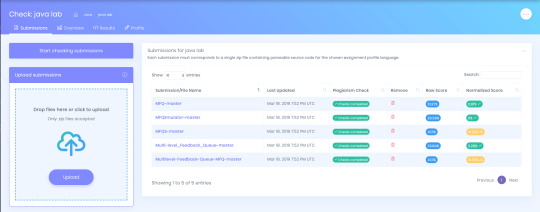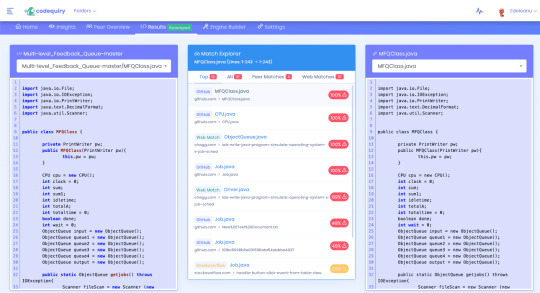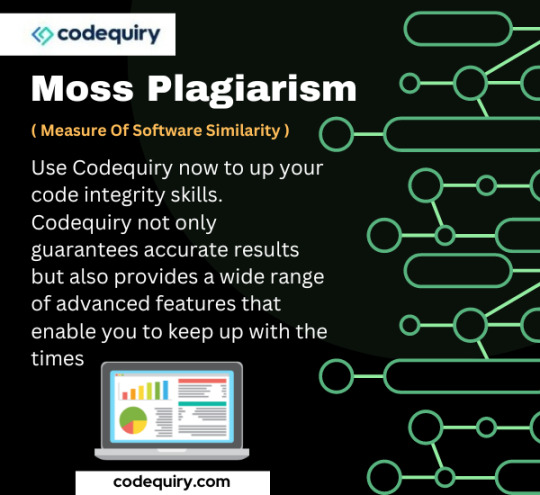#Moss Code Checker Moss Measure Of Software Similarity
Explore tagged Tumblr posts
Text
Detect Code Plagiarism Accurately with MOSS by Codequiry

Utilizing the Measure of Software Similarity (MOSS) algorithm, the Moss Plagiarism Checker by Codequiry effectively identifies code similarities. It compares your code against a vast database to detect potential plagiarism, making it an excellent tool for both developers and educators. Detailed reports ensure code originality and uphold high standards in programming, helping to maintain the integrity of submissions.
#Moss Plagiarism Checker#Moss Plagiarism#code plagiarism checker#plagiarism checker#code plagiarism#source code checker#code plagiarism detector#detect code plagiarism#code similarity checker#website plagiarism checker#codequiry
0 notes
Photo

Codequiry is one of the most efficient tools to check code for plagiarism. It makes it possible to objectively and automatically check all program solutions for evidence of copying. It makes the submission undergo a rigorous check to ensure that submissions are original and not copied. Altering variables, whitespace, function names, comments, and other features do not affect its similarity results.
0 notes
Text
Get the Code with Integrity on Online Code Plagiarism Checker
Codequiry its the best tool for online code plagiarism checker, here we provide the best solutions for code plagiarism. Get Start Free Now

#online code plagiarism checker#detect plagiarism in code#java code plagiarism checker#check java code for plagiarism#moss stanford#check code for plagiarism online#code similarity checker online#check code similarity#moss code checker#how to check code for plagiarism#source code plagiarism checker#plagiarism checker source code#moss software#moss code checker online#measure of software similarity#check source code for plagiarism
0 notes
Text
HW4proj
Answer:
Plagiarism occurs when an individual takes credit for the work of another. It can happen in a myriad of cases and is illegal. It should be avoided as the consequences can range from being expelled from school to being hit with a lawsuit. There are several methods for copying code and it is especially easy for a student or new programmer to fall into copying the code of someone else. Some instances that this can occur are using outside code from an unapproved source during a project or copying from another student. Copy and pasting makes the stealing of code very simple for a student or new programmer to do, especially if they are behind on a project deadline or due date. There are a few ways to avoid plagiarism according to Turn It In, these include using original variable names, commenting code that isn’t your own, and writing your website or blog text in a clean room. The first most important thing to do is to know when it is ok, and when it is not ok to utilize outside code in a project or assignment. Clear communication with your supervisor or professor is a good method of prevention. Finding a method to sort your original work from your copied work is also important. There are various code checkers available on the web. The Measure of Software Similarity Program or MOSS is utilized by Stanford and can be obtained by anyone. It is a method for professors to check code comparisons detected by the service. Some other programs that detect copied code are the YAP programs, the Plague program, the JPlag program, and the Code Match program. These programs have varying methods to obtain them. This could allow a programmer to check their own work, in some instances. The most commonly used programs within a university seem to be MOSS and JPlag because they use algorithms to check the similarities is compared code. However, some other programs check and compare things like the comments. A common method for plagiarizing in code is for the programmer to copy and paste the code into their project, then comment it out. They then alter the code to make it appear original. Google and search engines have created more access to source code, Source code is also more readily available than it has been in previous generations. This creates more of a need for plagiarism detectors. Most of the commonly used detectors compare active code and not code that has been commented out.
0 notes
Text
MOSS vs. Codequiry: Exploring the Evolution of Code Plagiarism Detection
Plagiarism in coding poses a significant challenge in academic and professional environments. Traditionally, tools like the Measure of Software Similarity (MOSS) have been relied upon to detect instances of code plagiarism. Developed by Stanford University, Moss Plagiarism Checker has been instrumental in identifying code similarities and promoting academic integrity. However, the emergence of alternatives like Codequiry signifies a shift towards more efficient and user-friendly solutions.

Codequiry, while similar to Moss Stanford in its objective, distinguishes itself through enhanced usability and result documentation. Its intuitive interface and detailed result documentation streamline the plagiarism detection process, allowing educators and professionals to focus more on meaningful discussions rather than grappling with complex software. Moreover, Codequiry's advanced engine offers customizable checks, catering to users' specific needs and providing greater control over plagiarism detection.
In addition to internal checks, Codequiry leverages the power of the internet to detect Code Plagiarism from billions of sources online. This comprehensive approach ensures a more thorough analysis and provides users with a broader perspective on code authenticity. By combining the strengths of MOSS with innovative features and user-centric design, Codequiry empowers users to uphold academic integrity and foster a culture of originality in coding education and practice.
#code plagiarism checke#code plagiarism checker#code plagiarism#moss stanford#moss code#detect code plagiarism#plagiarism checker#moss plagiarism checker#website plagiarism checker#code similarity checker#codequiry
1 note
·
View note
Text
Advanced Code Plagiarism Detection Beyond MOSS
The Stanford Code Plagiarism Checker, Measure of Software Similarity (MOSS), has long been relied upon by educators and publishers for detecting code plagiarism. However, Codequiry has emerged as a powerful alternative, addressing MOSS's limitations and revolutionizing the code plagiarism detection landscape.

Codequiry offers several advantages over MOSS, starting with its user-friendly interface. Unlike MOSS, which can be cumbersome to navigate, we streamline the process, allowing educators to spend less time grappling with software and more time engaging with students.
Furthermore, we provide comprehensive result documentation, enabling users to review and discuss findings with greater clarity. This feature is particularly valuable in cases where code similarities may arise from legitimate sources, ensuring a fair and transparent assessment process. With its ability to detect up to 11 billion web sources, Codequiry offers unparalleled precision and control in code Plagiarism Checker, empowering educators to maintain academic integrity and foster a culture of originality in coding education.
0 notes
Text
Software Similarity Testing by Using Codequiry’s MOSS.
Detecting cases of code plagiarism with results from billions of sources Measure of Software Similarity, or MOSS is a piece of software used by teachers and publishers to find software plagiarism. This software was developed by Stanford and has been the primary tool for checking code plagiarism. Codequiry is a similar program to the MOSS code. While MOSS was the first, Codequiry was created to improve on the weakness of the Moss program checker. Codequiry provides detailed results that matter the most along with giving you access to cutting-edge features.
0 notes
Text
Moss Plagiarism Checker: Measure Software Similarity to Improve Code Quality
Find an advanced technique that improves plagiarism detection. The way that code similarity is identified and handled has entirely changed thanks to CodeQuiry. Our platform uses logical algorithms that, compared with classic methods like the Moss plagiarism checker, not only find direct matches but also recognize similarities in logical patterns, creating a culture of continuous self-improvement. Our thorough checks ensure that every line of uploaded code is accurately inspected and that it is all subject to careful inspection. When you use CodeQuiry, you get more than just a plagiarism checker; you also get a tool that promotes learning, creativity, and moral coding.

0 notes
Text
Measure Of Software Similarity
Do you want to detect source code plagiarism using a reliable tool? Try Codequiry now as it’s one of the leading source code plagiarism detection tools. Compared to Measure Of Software Similarity (MOSS), Codequiry provides detailed results that matter the most along with giving you access to cutting-edge features. What’s more? Our tool supports more than 20 programming languages such as Java, C, C++, Python, C#, Go, PHP, and Perl! Get in touch now or learn more by visiting our website!
0 notes
Photo

Codequiry is a MOSS program checker that solves the growing problem of code plagiarism within the subject of computer science. Its engine is capable of generalizing across multiple languages including Java, C, C++, Python, C#, etc. Its algorithm combines a weighted average of three distinct similarity tests, providing an accurate submission to submission comparison result.
0 notes
Text
Top 10 Programming Plagiarism Checker Tools
Here Is the world to 10 best programming plagiarism checker tools that make your programming error and plagiarism free, here is Top 10 siteshttps://www.duplichecker.com/
https://codequiry.com/ https://copyleaks.com/ https://www.paperrater.com/
http://plagiarisma.net/ http://www.plagiarismchecker.com/ http://www.plagium.com/ https://www.plagscan.com/plagiarism-check/ https://www.plagtracker.com/ https://www.quetext.com
This Top 10 tool make vie best developer and its work every time with this tool you check check code for plagiarism online, Measure of Software Similarity, check code similarity, Measure of Software Similarity, plagiarism checker with sources, checkers cheat program, originality checker for students etc .
#plagiarism check code#plagiarism checker code#code similarity checker#programming plagiarism checker#check code for plagiarism online#check code similarity#code plagiarism#moss code#moss stanford#moss plagiarism#Moss Code Checker#Measure of Software Similarity#plagiarism in computer science#source code checker#copy checker#plagiarism detectors#+#plagiarism checker with sources#advanced plagiarism checker#moss plagiarism online#student plagiarism check#originality checker#plagiarism check program#checking for plagiarism software#code detector#does moss check github#checkers cheat program#plagiarism similarity checker#detect programming language by code online#python code checker online
0 notes
Link
Moss Stanford | Moss Plagiarism | Moss Code Checker Get your Moss Stanford, Moss Plagiarism, Moss Code Checker with world best tool codequiry
0 notes
Link
Moss Code | Moss Code Checker- Codequiry Make your code correctly with moss code checker. For more information visit on our tool Codequiry
#Moss Code Checker#advanced plagiarism checker#plagiarism detectors#programming plagiarism checker#check code for plagiarism online#plagiarism checker code#plagiarism check code#code plagiarism
0 notes